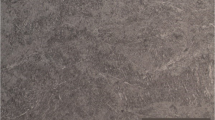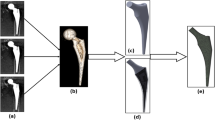Abstract
Four hyperelastic anizotropic constitutive equations are considered to model a selected knitted abdominal implant. The goal was to select the model, which provides numerical response of the implant under pressure load the closest to experimentally observed. The compared quantity was the position of the extreme reaction force induced by the pressure in the implant supports. All considered models revealed similar qualitative results, showing anizotropy of the material with preferential directions oblique to the implant knitting pattern. However, Gasser-Ogden-Holzapfel model showed the preferential direction closest to the experimentally determined and thus can be best recommended to model knitted abdominal implant under pressure load.
Access this chapter
Tax calculation will be finalised at checkout
Purchases are for personal use only
Similar content being viewed by others
References
Junge, K., Klinge, U., Prescher, A., Giboni, P., Niewiera, M., Schumpelick, V.: Elasticity of the anterior abdominal wall and impact for reparation of incisional hernias using mesh implants. Hernia 5, 113–118 (2001). https://doi.org/10.1007/s100290100019
Bittner, R., Bain, K., Bansal, V.K., et al.: Update of guidelines for laparoscopic treatment of ventral and incisional abdominal wall hernias (International Endohernia Society (IEHS)): Part A. Surg. Endosc. 33, 3069–3139 (2019). https://doi.org/10.1007/s00464-019-06907-7
Sommer, T., Friis-Andersen, H.: DynaMesh in the repair of laparoscopic ventral hernia: a prospective trial. Hernia. 17, 613–618 (2013). https://doi.org/10.1007/s10029-013-1090-y
Tomaszewska, A.: Mechanical behaviour of knit synthetic mesh used in hernia surgery. Acta Bioeng. Biomech. 18, 77–86 (2016). https://doi.org/10.5277/ABB-00185-2014-03Mechanical
Tomaszewska, A., Reznikov, D.: Combined numerical and experimental approach to determine numerical model of abdominal scaffold. Comput. Methods Biomech. Biomed. Engin. (2021). https://doi.org/10.1080/10255842.2021.2005788
Gasser, T.C., Ogden, R.W., Holzapfel, G.A.: Hyperelastic modelling of arterial layers with distributed collagen fibre orientations. J. R. Soc. Interface. 3(6), 15–35 (2006). https://doi.org/10.1098/rsif.2005.0073
Hernández-Gascón, B., et al.: Mechanical behaviour of synthetic surgical meshes: finite element simulation of the herniated abdominal wall. Acta Biomater. 7(11), 3905–3913 (2011). https://doi.org/10.1016/j.actbio.2011.06.033
Humphrey, J.D., Yin, F.C.: On constitutive relations and finite deformations of passive cardiac tissue: I. A pesudostrain-energy function. J. Biomech. Eng. 109(4), 298–304 (1987). https://doi.org/10.1115/1.3138684
Weiss, J.A., Maker, B.N., Govindjee, S.: Finite element implementation of incompressible transversely isotropic hyperelasticity. Comp. Methods Appl. Mech. Eng. 135, 107–128 (1996). https://doi.org/10.1016/0045-7825(96)01035-3
Lubowiecka, I.: Mathematical modelling of implant in an operated hernia for estimation of the repair persistence. Comput. Methods Biomech. Biomed. Eng. 18, 438–445 (2015). https://doi.org/10.1080/10255842.2013.807506
Tomaszewska, A., Lubowiecka, I., Szymczak, C.: Mechanics of mesh implanted into abdominal wall under repetitive load. Experimental and numerical study. J. Biomed. Mater Res. Part B. 107B, 1400–1409 (2019)
Cobb, W.S., Burns, J.M., Kercher, K.W., Matthews, B.D., Norton, H.J., Heniford, B.T.: Normal intraabdominal pressure in healthy adults. J. Surg. Res. 129, 231–235 (2005)
Acknowledgement
This work has been supported by the National Science Centre (Poland) (grant no. UMO-2017/27/B/ST8/02518). Calculations have been partially carried out at the Academic Computer Centre in Gdansk.
Author information
Authors and Affiliations
Corresponding author
Editor information
Editors and Affiliations
Rights and permissions
Copyright information
© 2024 The Author(s), under exclusive license to Springer Nature Switzerland AG
About this chapter
Cite this chapter
Reznikov, D., Tomaszewska, A. (2024). Modelling of Knitted Abdominal Implant in the Context of Constitutive Law Selection. In: Gzik, M., Paszenda, Z., Piętka, E., Tkacz, E., Milewski, K., Jurkojć, J. (eds) Innovations in Biomedical Engineering 2023. Lecture Notes in Networks and Systems, vol 875. Springer, Cham. https://doi.org/10.1007/978-3-031-52382-3_17
Download citation
DOI: https://doi.org/10.1007/978-3-031-52382-3_17
Published:
Publisher Name: Springer, Cham
Print ISBN: 978-3-031-52381-6
Online ISBN: 978-3-031-52382-3
eBook Packages: Intelligent Technologies and RoboticsIntelligent Technologies and Robotics (R0)




